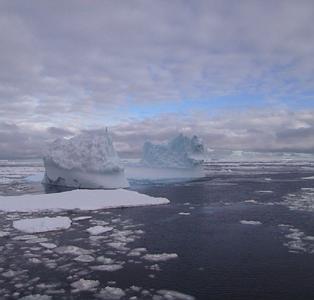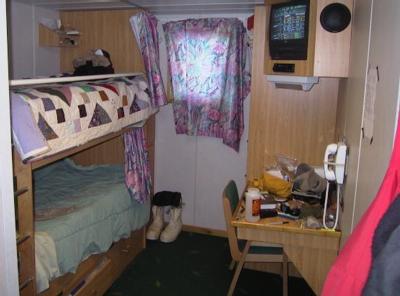21 March, 2000
A Hands-on Way to Antarctica
72 04s 105 40w
90 km (57 mi.) west of Cape Flying Fish, Thurston Island, Amundsen Sea
Wind S 9 knots (10 mph), temp -5 C (23 F), barometer 1001 mb, steady
Sky overcast, no precipitation
Depth 516 m (1693 ft)
Ship's course 324 @ 6 knots
In heavy pack with occasional open leads
Working out on deck is not so bad when the wind moderates, even if
you have just woken up. At midnight, when we were taking a piston core, the
wind was almost calm, and the temperature was near freezing. We were in
heavy pack ice, and there was no discernible swell. An occasional star or
two peaked out through holes in the clouds. I wouldn't have minded taking
snowshoes and hiking a mile or two away from the ship, just to feel the
dark and the emptiness out there.
Before leaving the coring spot we deployed (we don't just leave
things, we "deploy" them) an automated weather station in the middle of a
big stable floe. I didn't get to go down on the floe to see it set up,
because I was in the middle of labeling and storing the core. I did get a
picture of it ready to hoist down to the ice surface though. I'll post it
with this journal entry.
When set up, the station looks like a large cylindrical wash tub
with a head-high mast sticking up. The wash tub part, which is the base, is
dug into the snow on top of the ice, so that the wind won't blow it over.
In the base are batteries and a radio transmitter, while in the mast are
temperature and barometric pressure sensors. The transmitter is designed to
work with the same NOAA satellites that seal tracking transmitters do. The
satellite receives identification, position, temperature and barometer
information and stores it to retransmit later. The station has battery
power for more than a year, but probably will not last that long because
the floe will disintegrate earlier, sending it to the bottom.
We are setting up three of these buoys for Dr. H. Hellmer of the
Alfred Wegener Institute for Polar and Marine Research in Bremerhaven,
Germany. They are to be set up in a large triangle 60 nautical miles on a
side. Their purpose is to track large scale movements of the sea ice.
Additionally, their weather information is available to weather forecasters
worldwide.
As we were leaving, I caught a glimpse of the station set up on
the ice, starting its lonely duty. It reminded me of some NASA planetary
probe, radioing information from the back side of the moon.
If you want to plan and conduct your own scientific research in
Antarctica, pretty much the only way to do it is to get a Ph.D. and some
academic experience, apply for grants a year or more ahead of time, and
hope they are funded. But that route is by no means the only way that you
can live and work on this cold continent. People like Dee Breger come here
because they have special laboratory skills. Still others, like Synte
Peacock and Jesse Johnson are along because they are graduate students
doing relevant research. Sometimes undergraduate college students, like
Melissa Harper, are invited as research assistants, and there are other
programs specifically set up for undergraduates.
Besides these are yet other ways. None of the scientific research
being done here would be possible without a skilled crew experienced in
navigating Antarctic waters. Just as important are people with the skills
needed to run and maintain all the scientific equipment, from Zodiac boats,
to computers, to Kasten corers.
Steve Ager and Christian McDonald are in that last category. They
are marine technicians employed by Antarctic Support Associates (soon to be
replaced by Raytheon Polar Services Corporation), a company hired to
provide support services for American scientific research in Antarctica.
I've worked a lot with them, and can tell you that they know what they're
doing. Recently when we had a slow night I asked each of them to tell me
how they had come to be on the Nathaniel B. Palmer in the Amundsen Sea.
Steve told me that he went to high school in Tucson, and by his
own admission wasn't at the top of his class. In those days he was mostly
interested in girls and cars. Later he worked as a carpenter. He bought
houses in need of repair, and sold them at a profit. Then he decided to
return to school at Fort Lewis College in Colorado, and earned a Bachelor's
degree in Geology. About this time he was visiting a friend's house and saw
a pamphlet from Antarctic Support Associates advertising employment
opportunities in Antarctica.
He was interviewed, and Antarctic Support Associates (ASA) liked
his hands-on experience. He was hired for an all around support position
for the 1997-1998 season at McMurdo Station, and saw Antarctica for the
first time. Returning to Colorado, he went to ASA headquarters and applied
for his present job shipboard. Again he was hired, and has been working on
either the Nathaniel B. Palmer and sister ship Lawrence M. Gould ever
since. After we arrive in Puentas Arenas, Steve will board a five week
cruise on the Lawrence M. Gould, and then will head home for some time off
in Durango, Colorado.
"It's a good job, the pay is good, and I met my girlfriend down
here," Steve says.
I asked him what a marine technician's responsibilities were. He
listed some I knew: operating the Zodiacs, coring, CTDs, seismic surveying.
There were others also, including carpentry, metal fabrication, tool, spare
parts and hardware inventory, maintaining outboard motors and moving cargo.
Steve says that about the only things he and other ASA people don't do are
"drive the ship, cook meals, and put out fires." (Another contractor,
Edison Chouest, provides and maintains the ship and crew to safely run it
in some of the worst water in the world. There is a whole other story I'd
like to tell.)
Steve and Christian also have another responsibility shipboard.
They and other marine technicians are trained as wilderness emergency
medical technicians (EMTs.) If somebody were hurt, the EMTs would have to
stabilize the injury and provide care for weeks. There is no 911 to call in
the Amundsen Sea area, and the nearest doctor is more than a thousand miles
away.
Christian McDonald knew in high school that he wanted to work in
the marine science area when he grew up. He was on the swim team, and
started diving when he was 15.
He studied Marine Biology at the University of California at Santa
Cruz, became involved in scientific diving, and later taught the subject
there. While at Santa Cruz, his diving skills got him to Alaska for five
months. He helped in a study of sea otter ecology in the underwater kelp
forests that stretch along the Pacific coast from Baja California to the
Aleutians.
"Sea otters eat urchins, and urchins eat kelp. The sea otter
population was decimated in the last century, but now they are gradually
returning. What will happen to kelp and urchins when the otters come back?"
Christian first came to Antarctica in 1997 to help in a study of
pollution around McMurdo Station. Although in recent years efforts have
been made to reduce pollution at the base, in earlier times people were not
as concerned about the Antarctic environment. Parcticularly worrisome are
hydrocarbon and heavy metal pollution in Winter Quarter's Bay. Christian
placed samples with known pollutant levels on the bottom, and retrieved
them later to find out what organisms could tolerate what levels of
pollution. The 1998 season brought him back to work in the same study.
More recently, he has been at McMurdo working with famed
underwater photographer Norbert Wu (see recent National Geographic Magazine
arcticle) making a marine natural history film to be released in February
2001. Christian joined a team of divers filming with high definition
television cameras, working through the two meter thick sea ice. He says a
drill like those used for phone poles, except larger, drilled a four foot
(1.22 m) hole. They worked from a heated dive hut dragged over the hole.
He expects to return next season to finish work on the film.
More schooling is in Christian's future. In between diving he
plans to start graduate school at Moss Landing Marine Laboratory in
California, to study marine ecology.
"I'm itching to get back to school," he says.
As I've been writing this, the sky has cleared to a cobalt blue,
setting off the white ice on the blue-black sea. I'm hoping that the
weather holds and I'll have a sky full of Antarctic stars tonight.

Jay Ardai and Craig Huhta setting up an automatic weather station to be left on an ice floe. This one was set up the morning after the one I wrote about in this journal entry.

It is a blue, gray and white world down here, but I never get tired of looking at it.

My cabin aboard the Nathaniel B. Palmer. My bunk is the upper one, the one with the pretty quilt. Neither my room mate, Doug Introne, nor I are neatness fanatics.
Contact the TEA in the field at
.
If you cannot connect through your browser, copy the
TEA's e-mail address in the "To:" line of
your favorite e-mail package.
|
